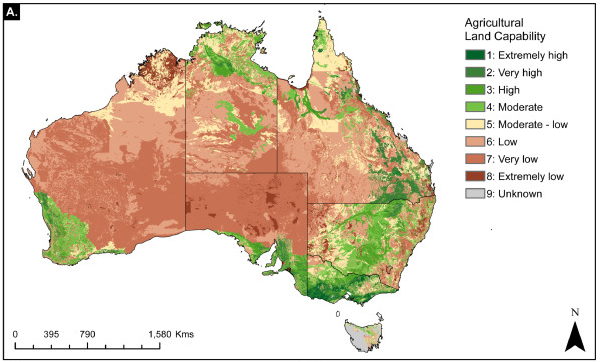Humans having been changing the surface of our planet for millennia, however the pace is rapidly increasing. Habitat loss due to land-cover change is the main threat to 85% of IUCN Red List species. Additionally, land-cover change has drastic effects on global carbon and water cycles, among countless other ecosystem services. Understanding where, how, and why humans change the surface of the planet is essential to predicting and mitigating the worst impacts.
Peer-Reviewed Publications
THREATENED FAUNA PROTECTIONS COMPROMISED BY AGRICULTURAL INTERESTS IN AUSTRALIA. Engert, Pressey & Adams. (2023). Conservation Letters.
-
Abstract
-
Article
<
>
Australia is a global leader in land clearing and biodiversity loss. The overwhelming majority of land clearing within Australia and, globally, is driven by agricultural conversion. The importance of agricultural lands also leads to the concentration of habitat protection in landscapes that do not support productive land uses, which might contribute to species conservation in marginal habitat. Using an integrated agricultural capability map and threatened vertebrate fauna range maps, we show that observed biases in protected area location have varied impacts at the species level. Specifically, threatened vertebrate fauna with habitat capable of supporting high-value productive lands received less protection and experienced greater habitat loss. Similarly, almost all species assessed received protection in the portions of their ranges less conducive to productive land uses. Finally, we identify regions of Australia at risk of future land clearing and the species likely to bear the brunt of the impacts. Our results demonstrate the importance of protecting land capable of supporting productive uses to conserve the most affected threatened species.
PROTECTED, CLEARED, OR AT RISK: THE FATE OF AUSTRALIAN PLANT SPECIES UNDER CONTINUED LAND USE CHANGE. Adams et al. (2023). Biological Conservation.
-
Abstract
-
Article
<
>
Land clearing and protected area provision are two contrasting forces shaping the persistence of species in the landscape. Using Australia's flora as a case study, we characterize the three possible states of species persistence: protected, cleared, or at risk of future loss based on agricultural capability, using a comprehensive suite of plant distributions and traits. We test the assumption that plant species, assemblages, and growth forms are adequately preserved in protected areas in Australia, and contrast this result with historic and future loss driven by trajectories of continued land clearing. We find levels of protection and clearing are inversely related, with both bioregions and species with high levels of clearing having low protection. We find only one third of Australian bioregions meet international protection targets of 30 % of area in formal protection. Similarly, we find that 29 % of plant species have met representation protection targets (with 30 % of their range protected), while similar numbers (33 %) have clearing as the dominant land use across their ranges. Protection and clearing have also unevenly affected species with different growth forms, range sizes, and distributions across agricultural land capability. Narrow-ranged woody species (e.g., trees) are the most at-risk group in relation to clearing, whereas large-ranged non-woody species (e.g., graminoids, herbs) are afforded a high level of protection in reserved lands. We demonstrate that the Australian protected-area network, although theoretically underpinned by sound CAR principles (comprehensive, adequacy, representativeness), falls short in protecting both individual plant species and growth forms.
AUSTRALIAN AGRICULTURAL RESOURCES: A NATIONAL SCALE LAND CAPABILITY MAP. Adams & Engert. (2022). Data in Brief.
-
Abstract
-
Article
<
>
Ongoing land clearing is a key driver of biodiversity loss and climate change. Effective action to halt land clearing and land degradation ultimately relies on understanding patterns of land capability for production uses, in particular agriculture, as a key driver of land use. Here we describe a national agricultural land capability map for Australia, based on harmonized state agricultural land capability datasets and modelled pastoral capability. State-level agricultural land capability datasets capture regional variations in crop selection and suitability. Hence, we reclassified these datasets to fit a nationally consistent land capability ranking scheme. For regions in which agricultural capability data was not available, we modelled agricultural and pastoral capability and mapped this to the same ranking scheme. The national land capability dataset fills an immediate knowledge need for Australia. This dataset has wide potential for utilization, such as for retrospective analysis of land use policies and prospective regional planning initiatives to ensure forward looking policies and land use plans optimize land allocation.
Popular Publications
Currently nothing to display here.
Media
Currently nothing to display here.
Data
|
Agricultural capability map of Australia.
Citation: Adams, VM. & Engert, JE. (2022). Australian agricultural resources: A national scale land capability map. Data in Brief, 108852. This file contains a national agricultural land capability map for Australia, based on state agricultural land capability datasets reclassified to a single agricultural land capability classification (NSW method) and modeled grazing suitability. |
